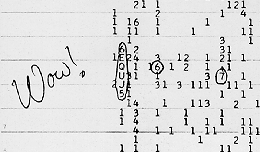|
|
| (未显示2个用户的16个中间版本) |
| 第1行: |
第1行: |
| − | <资料来源:[http://www.planetary.org/explore/topics/seti/seti_history_10.html The Planetary Society]> | + | <资料来源:[https://archive.md/2007.07.02-184057/http://www.planetary.org/explore/topics/seti/seti_history_10.html Wow!]> |
| | | | |
| | | | |
| | =='''第10章:“哇!”'''== | | =='''第10章:“哇!”'''== |
| | | | |
| − | The longest running as well as one of the most famous searches was conducted with the use of the giant "Big Ear" radio telescope at Ohio State University. "Big Ear" was no ordinary radio-telescope: instead of the familiar "dish," it was composed of a flat aluminum surface the size of three football fields, with a giant reflector at each end - one flat and one parabolic. Its sensitivity was equivalent to that of a 175-foot dish. From 1973 up to its dismantling in 1998 (to make room for a golf course), its most important mission was a continuous dedicated hydrogen-line SETI search.
| + | [[SETI]] 史上持续时间最长,也是最有名的搜索项目之一,使用的是俄亥俄州立大学巨大的“大耳朵(Big Ear)”射电望远镜。“大耳朵”可不是什么普通的射电望远镜,和一般射电望远镜的碟状天线不同,它是由一个和足球场差不多大小的平面铝制表面、以及两端的巨型反射器组成的,两个反射器一个是平的,另一个是抛物线的。“大耳朵”从灵敏度来看和一个 175 英尺大小的碟状天气差不多。从 1973 年一直到 1998 年天线被拆除(改为高尔夫培训用),它的最主要使命就是持续而专注地进行氢线附近的 SETI 搜索。 |
| | | | |
| | | | |
| − | The most famous moment in the history of Big Ear, which earned it a place of honor in the annals of SETI, came on the night of August 15, 1977. As on every other night, as Big Ear was searching the skies for an alien signal, its observations were being recorded on a printout sheet: a long list of letters and numbers was continuously being churned out, one long list for every one of the fifty channels scanned by the telescope. A list of characters appeared recording an unusual transmission at the frequency of channel 2: "6EQUJ5" the list read. This startled Big Ear volunteer Jerry Ehman, a professor at Franklin University in Columbus, who was monitoring the readings that night. He circled the code for later reference and added a single comment in the margins" "Wow!"
| + | “大耳朵”历史上最著名的时刻,也是为它在 SETI 的历史上赢得了一席荣誉之地的时刻,是 1977 年 8 月 15 日的晚上。像其它普通的晚上一样,大耳朵正对着天空寻找着外星文明的信号,它观测到的东西都是通过打印纸输出的,也就是持续不断地将一长串的数字和字母地记录下来,望远镜所扫描的五十个频段,每一个都对应一长串输出列表。而当时是对应第二频段的记录列表中出现了一串表明在对应频率段有不寻常信号的代码“6EQUJ5”,这串代码着实震惊了大耳朵的的志愿者 Jerry Ehman,位于 Columbus 的 Franklin 大学的一名教授,他那晚正在监视扫描系统所输出的内容。然后他就在那串代码上标上了圆圈,以方便往后的查阅,并且在旁边加上了一个简单的注释“哇!(Wow!)” |
| | | | |
| | | | |
| − | [[Image:Bigear.gif|left|thumb|424px|'''Big Ear'''<br> | + | [[Image:Bigear.gif|left|thumb|424px|'''大耳朵(Big Ear)'''<br> |
| − | The Big Ear Radio Telescope at Ohio State University, as it appeared before its demolition in 1998. Credit: The Big Ear Observatory]]
| + | 俄亥俄州立大学的大耳朵射电望远镜,拍摄于 1998 年被拆除前。图片提供:大耳朵观测站]] |
| | | | |
| − | This was, of course, the famous "Wow!" signal, which immediately entered SETI lore. The series "6EQUJ5" described the strength of the received signal over a short time-span. In the system used at the time at Big Ear, each number from 1 to 9 represented the signal level above the background noise. In order to extend the scale, the staff added letters, with each one from A to Z representing increasingly stronger signal levels. 6EQUJ5 represented a signal that grew in strength to level "U," and then gradually subsides. In more familiar notation, the signal increased from zero to level 30 "sigmas" above the background noise, and then decreased again to zero, all in the span of 37 seconds.
| + | 这个著名的“哇!”信号很快就成为了 SETI 历史中的传说。代码“6EQUJ5”所描述的是在一个短的时间间隔内接收到的信号强度。在大耳朵当时使用的系统中,用 1 到 9 的数字表示嗓音背景之上的信号强度水平,而为了扩展强度范围,工作人员还使用了从 A 到 Z 的字母来表示更高的信号强度水平。6EQUJ5 表示的是一个中心最大强度为 U 而两端强度逐渐下降的信号。说得更通俗一些,这个信号从零增加到噪音背景之上的第 30 级(译注:9 个数字级别加上 21 个字母级别),然后再逐渐减少至零,前后持续时间为 37 秒。 |
| | | | |
| | | | |
| − | Two aspects of this signal immediately caught the attention of Ehman and project director John Kraus, who saw the results the following morning. First of all, 37 seconds was precisely the time it takes the Big Ear scanning beam to survey a given point in the heavens. Because of this, any signal coming from space would follow precisely the "Wow!" signal's pattern - increasing and then decreasing over 37 seconds. This practically ruled out the possibility that the signal was the result of Earthly radio interference.
| + | 这个信号从两个方面立即引起了 Ehman 和项目负责人 John Kraus 的注意,后者是在第二天早上看到结果的。首先,37 秒正是大耳朵对天空中指定位置进行一次扫描的持续时间。因此,如果是来自太空中的信号,则必然是符合“哇!”信号的模式 - 也就是在 37 秒内先增加再减小。这就排除了信号是来自于地基的无线电干扰的可能性。 |
| | | | |
| | | | |
| − | Secondly, the signal was not continuous, but intermittent. Kraus and Ehman knew that, because Big Ear has two separate beams that scan the same area of the sky in succession, several minutes apart. But the signal appeared on only on of the beams and not on the other, indicating that it had been "turned off" between the two scans. A strong, focused and intermittent signal coming from outer space: Could it be that Big Ear had detected an alien signal?
| + | 其次,这个信号是间断非连续的。Kraus 和 Ehman 之所以知道这点,是因为大耳朵有两个独立的扫描波束,会相继对天空中的同一个区域进行扫描,时间间隔是几分钟。但这个信号只出现在其中一个波束的扫描结果中,这也意味着这个信号在两次扫描的间隔期就“关闭”了。所以这是一个来自外太空的强度大、方向性好、非连续的信号,那有没有可能大耳朵探测到的正是某个外星文明的信号? |
| | | | |
| | | | |
| − | [[Image:Wowsignal.gif|right|thumb|260px|'''The Wow Signal'''<br> | + | [[Image:Wowsignal.gif|right|thumb|260px|'''“哇!”信号'''<br> |
| − | The computer printout of the "Wow!" signal, along with Jerry Ehman's famous comment. Credit: The Big Ear Observatory]]
| + | 计算机输出的“哇!”信号,旁边是 Jerry Ehman 那著名的注释。图片提供:大耳朵观测站]] |
| | | | |
| − | Since 1977 several attempts had been made to find the "Wow!" signal once more - to no avail. To this day we do not know the source of the strongest and clearest signal ever to come through on a SETI search. Since it was undoubtedly artificial, and almost certainly of celestial origin, Jerry Kraus speculates that it may have come from a space probe (human space probe, that is…) that he and the Big Ear staff were not aware of. That would certainly make it an intelligent celestial signal, but not an alien one. And still, there is always the possibility that it was something else - a true signal from an alien civilization. Unless the signal is detected again, we may never know for sure.
| + | 1977 年之后,人们多次去尝试看看能不能再次探测到“哇!”信号,但却从未成功。直到今天,我们仍然不知道这个有史以来所有 SETI 搜索中发现的最强、最清晰的信号从何而来。既然它毫无疑问是人工产生的信号,而且来自于太空,Jerry Kraus 推测它可能是由某一次他和大耳朵工作人员都不知道的太空探测活动所引起的(也就是说是人类进行的太空探测活动)。这确实是来自智慧生命的太空信号,只可惜不是从外星人那里发过来的。当然,其它的可能性也仍然是存在的 - 比如这真是来自外星文明的信号。但是,除非我们再次探测到这个信号,否则我们将永远不知道真实的答案。 |
| | | | |
| | | | |
| − | [[SETI的历史:9:Ozpa - A Skeptics Search,Opza - 一个怀疑论者的搜索|'''第9章:Opza - 一个怀疑论者的搜索 ←''']] | [[SETI的历史:11:NASA Steps In,美国航太总署的介入|'''→ 第10章:美国航太总署的介入''']] | + | [[SETI 的历史|'''返回 SETI 的历史 ←''']] | [[SETI 的历史 - 9|'''第9章:Ozpa - 一个怀疑论者的搜索 ←''']] | [[SETI 的历史 - 11|'''→ 第11章:NASA(美国航空航天局)的介入''']] |
| − | | |
| − | | |
| − | ==相关链接==
| |
| − | *[[SETI]]
| |
| − | *[[SETI@home]]
| |
| − | *[[SETI的历史]]
| |
| − | | |
| − | [[Category:SETI@home相关文献]][[Category:文献翻译]]
| |
<资料来源:Wow!>
第10章:“哇!”
SETI 史上持续时间最长,也是最有名的搜索项目之一,使用的是俄亥俄州立大学巨大的“大耳朵(Big Ear)”射电望远镜。“大耳朵”可不是什么普通的射电望远镜,和一般射电望远镜的碟状天线不同,它是由一个和足球场差不多大小的平面铝制表面、以及两端的巨型反射器组成的,两个反射器一个是平的,另一个是抛物线的。“大耳朵”从灵敏度来看和一个 175 英尺大小的碟状天气差不多。从 1973 年一直到 1998 年天线被拆除(改为高尔夫培训用),它的最主要使命就是持续而专注地进行氢线附近的 SETI 搜索。
“大耳朵”历史上最著名的时刻,也是为它在 SETI 的历史上赢得了一席荣誉之地的时刻,是 1977 年 8 月 15 日的晚上。像其它普通的晚上一样,大耳朵正对着天空寻找着外星文明的信号,它观测到的东西都是通过打印纸输出的,也就是持续不断地将一长串的数字和字母地记录下来,望远镜所扫描的五十个频段,每一个都对应一长串输出列表。而当时是对应第二频段的记录列表中出现了一串表明在对应频率段有不寻常信号的代码“6EQUJ5”,这串代码着实震惊了大耳朵的的志愿者 Jerry Ehman,位于 Columbus 的 Franklin 大学的一名教授,他那晚正在监视扫描系统所输出的内容。然后他就在那串代码上标上了圆圈,以方便往后的查阅,并且在旁边加上了一个简单的注释“哇!(Wow!)”

大耳朵(Big Ear) 俄亥俄州立大学的大耳朵射电望远镜,拍摄于 1998 年被拆除前。图片提供:大耳朵观测站
这个著名的“哇!”信号很快就成为了 SETI 历史中的传说。代码“6EQUJ5”所描述的是在一个短的时间间隔内接收到的信号强度。在大耳朵当时使用的系统中,用 1 到 9 的数字表示嗓音背景之上的信号强度水平,而为了扩展强度范围,工作人员还使用了从 A 到 Z 的字母来表示更高的信号强度水平。6EQUJ5 表示的是一个中心最大强度为 U 而两端强度逐渐下降的信号。说得更通俗一些,这个信号从零增加到噪音背景之上的第 30 级(译注:9 个数字级别加上 21 个字母级别),然后再逐渐减少至零,前后持续时间为 37 秒。
这个信号从两个方面立即引起了 Ehman 和项目负责人 John Kraus 的注意,后者是在第二天早上看到结果的。首先,37 秒正是大耳朵对天空中指定位置进行一次扫描的持续时间。因此,如果是来自太空中的信号,则必然是符合“哇!”信号的模式 - 也就是在 37 秒内先增加再减小。这就排除了信号是来自于地基的无线电干扰的可能性。
其次,这个信号是间断非连续的。Kraus 和 Ehman 之所以知道这点,是因为大耳朵有两个独立的扫描波束,会相继对天空中的同一个区域进行扫描,时间间隔是几分钟。但这个信号只出现在其中一个波束的扫描结果中,这也意味着这个信号在两次扫描的间隔期就“关闭”了。所以这是一个来自外太空的强度大、方向性好、非连续的信号,那有没有可能大耳朵探测到的正是某个外星文明的信号?

“哇!”信号 计算机输出的“哇!”信号,旁边是 Jerry Ehman 那著名的注释。图片提供:大耳朵观测站
1977 年之后,人们多次去尝试看看能不能再次探测到“哇!”信号,但却从未成功。直到今天,我们仍然不知道这个有史以来所有 SETI 搜索中发现的最强、最清晰的信号从何而来。既然它毫无疑问是人工产生的信号,而且来自于太空,Jerry Kraus 推测它可能是由某一次他和大耳朵工作人员都不知道的太空探测活动所引起的(也就是说是人类进行的太空探测活动)。这确实是来自智慧生命的太空信号,只可惜不是从外星人那里发过来的。当然,其它的可能性也仍然是存在的 - 比如这真是来自外星文明的信号。但是,除非我们再次探测到这个信号,否则我们将永远不知道真实的答案。
返回 SETI 的历史 ← | 第9章:Ozpa - 一个怀疑论者的搜索 ← | → 第11章:NASA(美国航空航天局)的介入

